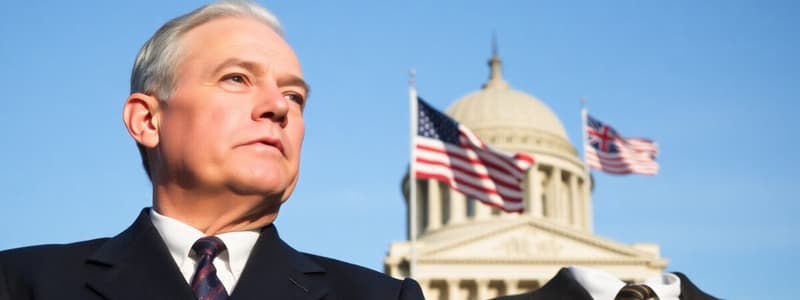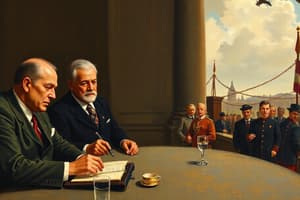Podcast
Questions and Answers
What was the primary purpose of the Truman Doctrine as announced in 1947?
What was the primary purpose of the Truman Doctrine as announced in 1947?
- To assist Greece against Communist forces (correct)
- To establish military bases in Europe
- To promote economic growth in Europe
- To encourage alliances with non-Communist countries
Which plan was introduced in June 1947 to aid European recovery?
Which plan was introduced in June 1947 to aid European recovery?
- The Marshall Plan (correct)
- The Berlin Airlift Initiative
- The NATO Agreement
- The Warsaw Pact
What was the impact of the currency reform in West Germany during 1948?
What was the impact of the currency reform in West Germany during 1948?
- It led to the unification of Germany
- It improved the economy of West Berlin (correct)
- It caused a decline in industrial production
- It resulted in widespread poverty throughout Europe
What was the response of the USSR to the Marshall Plan?
What was the response of the USSR to the Marshall Plan?
What was the Berlin Airlift primarily a response to?
What was the Berlin Airlift primarily a response to?
Which of the following statements accurately describes the outcome of the Berlin Blockade?
Which of the following statements accurately describes the outcome of the Berlin Blockade?
What were the two German states formed after World War II?
What were the two German states formed after World War II?
Why did Stalin block access routes to West Berlin in 1948?
Why did Stalin block access routes to West Berlin in 1948?
What should you always consider when interpreting sources?
What should you always consider when interpreting sources?
Why is it important to place sources in their correct historical context?
Why is it important to place sources in their correct historical context?
How can you utilize the glossary and textboxes in the Learner’s Book effectively?
How can you utilize the glossary and textboxes in the Learner’s Book effectively?
What should you do to ensure clear communication of your points of view?
What should you do to ensure clear communication of your points of view?
What is a beneficial approach to make content knowledge your own?
What is a beneficial approach to make content knowledge your own?
Linking sections to past knowledge is useful for what purpose?
Linking sections to past knowledge is useful for what purpose?
Which of the following questions does studying history help us answer?
Which of the following questions does studying history help us answer?
Why is studying history considered exciting and dynamic?
Why is studying history considered exciting and dynamic?
What was the primary reason for Ho Chi Minh's involvement in the French Communist Party in the 1920s?
What was the primary reason for Ho Chi Minh's involvement in the French Communist Party in the 1920s?
Which colonial power controlled Vietnam before the involvement of the French?
Which colonial power controlled Vietnam before the involvement of the French?
What was the outcome of the Sino-French War from 1864 to 1885?
What was the outcome of the Sino-French War from 1864 to 1885?
What was one way the French claimed to modernize Vietnam during their colonial rule?
What was one way the French claimed to modernize Vietnam during their colonial rule?
What significant action did Ho Chi Minh take upon returning to Vietnam in 1941?
What significant action did Ho Chi Minh take upon returning to Vietnam in 1941?
What did Ho Chi Minh declare after occupying Hanoi post-World War II?
What did Ho Chi Minh declare after occupying Hanoi post-World War II?
How did life for Vietnamese peasants change under French colonial rule?
How did life for Vietnamese peasants change under French colonial rule?
What role did Vietnamese resistance play prior to Ho Chi Minh's organization of the Vietnam Revolutionary League?
What role did Vietnamese resistance play prior to Ho Chi Minh's organization of the Vietnam Revolutionary League?
What ideology did many newly independent African states choose to avoid capitalism?
What ideology did many newly independent African states choose to avoid capitalism?
Which of the following is a characteristic of a multi-party system?
Which of the following is a characteristic of a multi-party system?
What is a common outcome in African states that did not adhere to democratic principles?
What is a common outcome in African states that did not adhere to democratic principles?
How is majority rule typically balanced in a democratic system?
How is majority rule typically balanced in a democratic system?
Which leader characteristic is often associated with a one-party state?
Which leader characteristic is often associated with a one-party state?
What major movement did Mao launch in May 1966 to reassert his authority?
What major movement did Mao launch in May 1966 to reassert his authority?
What often provides support for dictators in one-party states?
What often provides support for dictators in one-party states?
In the context of democracy, what do regular elections and free campaigns allow for?
In the context of democracy, what do regular elections and free campaigns allow for?
What role did the Red Guards play during the cultural revolution initiated by Mao?
What role did the Red Guards play during the cultural revolution initiated by Mao?
What is a major reason why many African leaders did not respect democratic principles?
What is a major reason why many African leaders did not respect democratic principles?
How did Mao view the relationship with Stalin and the COMINTERN?
How did Mao view the relationship with Stalin and the COMINTERN?
What was a significant consequence of the famine in China during the early 1960s?
What was a significant consequence of the famine in China during the early 1960s?
What was Mao's response to the cultural revolution by the late 1960s?
What was Mao's response to the cultural revolution by the late 1960s?
During the Korean War, how did Mao's decisions impact Chinese society?
During the Korean War, how did Mao's decisions impact Chinese society?
What was a direct result of Mao's initial economic policies?
What was a direct result of Mao's initial economic policies?
What did Mao's support for North Vietnam during the Vietnam War symbolize?
What did Mao's support for North Vietnam during the Vietnam War symbolize?
What event prompted the US Congress to pass the Gulf of Tonkin Resolution?
What event prompted the US Congress to pass the Gulf of Tonkin Resolution?
Which theory justified US involvement in the Vietnam War by suggesting the necessity to stop the spread of communism?
Which theory justified US involvement in the Vietnam War by suggesting the necessity to stop the spread of communism?
Who became the President of South Vietnam in 1965?
Who became the President of South Vietnam in 1965?
What was the main purpose of Operation Rolling Thunder?
What was the main purpose of Operation Rolling Thunder?
Which chemical was used primarily to defoliate jungles in Vietnam?
Which chemical was used primarily to defoliate jungles in Vietnam?
What was the objective of the Tet Offensive in 1968?
What was the objective of the Tet Offensive in 1968?
Which military operation involved bombing campaigns against Communists during the Vietnam War?
Which military operation involved bombing campaigns against Communists during the Vietnam War?
What was Agent Blue used for during the Vietnam War?
What was Agent Blue used for during the Vietnam War?
Flashcards
Multiple Perspectives
Multiple Perspectives
Considering multiple perspectives on the same historical event helps to get a more complete understanding. For example, a source from the United States about a Cold War event will likely have a different perspective than a source from the Soviet Union.
Source Attribution
Source Attribution
Always note the source of information. Consider who created the source, its intended purpose, and when it was created. This helps understand the source's potential bias and context.
Historical Context
Historical Context
Understanding the historical context of a source is crucial to interpret it accurately. Knowing the time period, key events, and relevant social conditions helps to understand the source.
Historical Vocabulary
Historical Vocabulary
Signup and view all the flashcards
Identifying Key Elements
Identifying Key Elements
Signup and view all the flashcards
Clear Communication
Clear Communication
Signup and view all the flashcards
Connecting Past and Present
Connecting Past and Present
Signup and view all the flashcards
Active Learning
Active Learning
Signup and view all the flashcards
Great Proletarian Cultural Revolution
Great Proletarian Cultural Revolution
Signup and view all the flashcards
Red Guards
Red Guards
Signup and view all the flashcards
DeStalinisation
DeStalinisation
Signup and view all the flashcards
Sino-Soviet Split
Sino-Soviet Split
Signup and view all the flashcards
Sino-Soviet Treaty of Friendship
Sino-Soviet Treaty of Friendship
Signup and view all the flashcards
Chinese Intervention in the Korean War
Chinese Intervention in the Korean War
Signup and view all the flashcards
Mao's Initial Economic Policies
Mao's Initial Economic Policies
Signup and view all the flashcards
Chinese Famine of 1961
Chinese Famine of 1961
Signup and view all the flashcards
The Truman Doctrine
The Truman Doctrine
Signup and view all the flashcards
Marshall Plan
Marshall Plan
Signup and view all the flashcards
The Berlin Blockade
The Berlin Blockade
Signup and view all the flashcards
The Berlin Airlift
The Berlin Airlift
Signup and view all the flashcards
Division of Germany
Division of Germany
Signup and view all the flashcards
Currency Reform in West Berlin
Currency Reform in West Berlin
Signup and view all the flashcards
Communist Information Bureau (COMINFORM)
Communist Information Bureau (COMINFORM)
Signup and view all the flashcards
Cold War Tension
Cold War Tension
Signup and view all the flashcards
French Colonial Rule in Vietnam
French Colonial Rule in Vietnam
Signup and view all the flashcards
Establishment of Cochinchina
Establishment of Cochinchina
Signup and view all the flashcards
French Economic Exploitation of Vietnam
French Economic Exploitation of Vietnam
Signup and view all the flashcards
French Centralized Government in Vietnam
French Centralized Government in Vietnam
Signup and view all the flashcards
Vietnamese Resistance Against French Colonial Rule
Vietnamese Resistance Against French Colonial Rule
Signup and view all the flashcards
Who was Ho Chi Minh?
Who was Ho Chi Minh?
Signup and view all the flashcards
The Viet Minh
The Viet Minh
Signup and view all the flashcards
French Recolonization of Vietnam
French Recolonization of Vietnam
Signup and view all the flashcards
Democracy
Democracy
Signup and view all the flashcards
One-party state
One-party state
Signup and view all the flashcards
Dictatorship
Dictatorship
Signup and view all the flashcards
Rule of law
Rule of law
Signup and view all the flashcards
Elected representatives
Elected representatives
Signup and view all the flashcards
Authoritarianism
Authoritarianism
Signup and view all the flashcards
Gulf of Tonkin Resolution
Gulf of Tonkin Resolution
Signup and view all the flashcards
Domino Theory
Domino Theory
Signup and view all the flashcards
Phase 2 of the Vietnam War
Phase 2 of the Vietnam War
Signup and view all the flashcards
Agent Orange
Agent Orange
Signup and view all the flashcards
Agent Blue
Agent Blue
Signup and view all the flashcards
Tet Offensive
Tet Offensive
Signup and view all the flashcards
Objective of the Tet Offensive
Objective of the Tet Offensive
Signup and view all the flashcards
Impact of the Tet Offensive
Impact of the Tet Offensive
Signup and view all the flashcards
Study Notes
No specific text or questions provided. Please provide the text or questions you would like me to create study notes for.
Studying That Suits You
Use AI to generate personalized quizzes and flashcards to suit your learning preferences.




